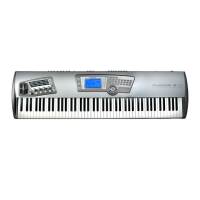2
Chapter 2: Fusion Basics
36
Connecting to a Computer via USB
The Fusion’s USB port allows you to connect your Fusion to a computer.
This is a very useful feature since it allows you to transfer programs,
mixes, songs, samples, multisamples, and arpeggiation patterns to (and
from) your computer. Once you have your files on your computer, you
can back them up for safe-keeping, give them to friends who own
Fusion workstations, or even share your Fusion related files over the
Internet.
This opens up a lot of possibilities, but you must be careful not to
disrupt existing file references by moving (or deleting) files or folders
on the Fusion’s hard disk. In other words, don’t move (or delete) files
unless you’re sure that doing so won’t affect your other files!
This sounds complicated, so let’s break it down into a real-world
example: Let’s say you move a program to a different folder (using either
the Fusion’s own Item Explorer or through the USB connection). The
next time you fire up your Fusion and try to load a mix or song that
needs the program you just moved, you’ll get an error message telling
you that the program can’t be found. You’ll then have the option to tell
the Mix or Song where it can find the moved program. Now, if you
had deleted that program you’d be in trouble because the song or mix
would no longer be able to load the program.
The moral of the story is this: move and delete files carefully and make
sure that doing so won’t have unintended consequences!
Formatting the Hard Disk:
Do not format the Fusion’s internal hard
disk via USB. Using USB to format the hard
disk may severely degrade audio playback
performance.
Instead, use the “Format” function in
Global mode (see page 193) since that will
ensure that the drive is formatted for optimal
audio performance.
Moving or Deleting Files:
Be very careful whenever you move or delete
any files on your Fusion. If you move (or
delete) a file, all other files referencing the
moved or deleted item will become invalid
and this may turn into an unexpected
headache for you.
If you do move files, you’ll need to update all
other files that refer to the moved file. If you
delete files, make sure they are not
referenced by any other files.

